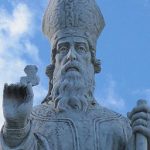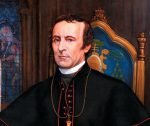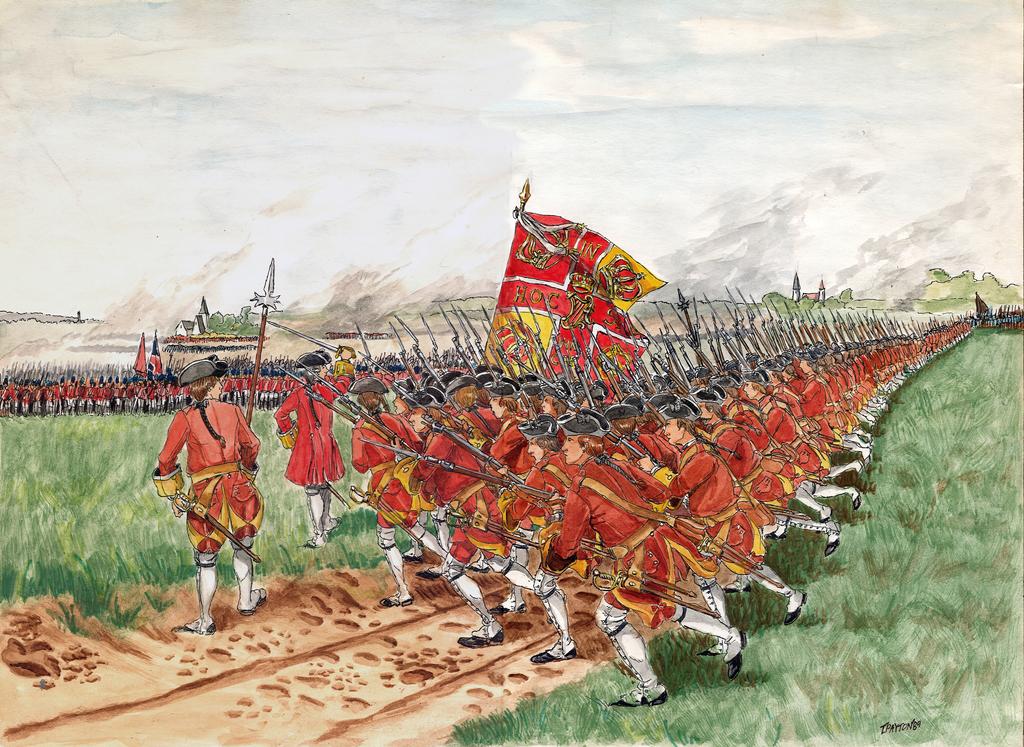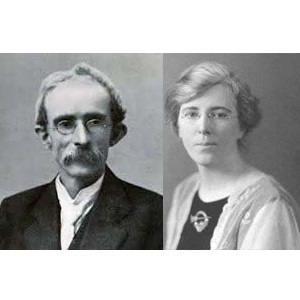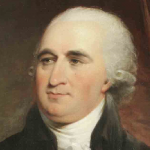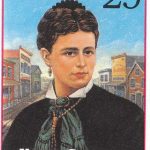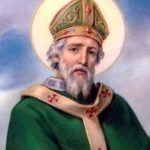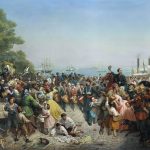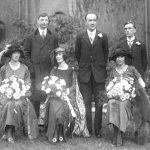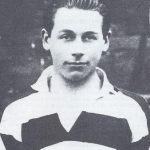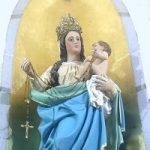Each year around March 17, the name of St. Patrick appears in every major publication in the civilized world - sometimes with honor and sometimes with scorn - often due to the conduct of those who celebrate his memory at affairs which bear his name. Of the many things written about this holy man, some are true, some misleading, and some false. St. Patrick was Italian; St. Patrick drove the snakes from Ireland; St. Patrick was the first to bring Christianity to Ireland - all of these statements are false! Let’s take them one at a time. Some claim St. Patrick to be Italian … [Read more...] about Who is St. Patrick?
Irish American Heritage Month: Archbishop “Dagger John” Hughes
John Joseph Hughes was born on 24 June 1797 in Annaloghan, Co. Tyrone, to a poor farmer. As a Catholic in English-ruled Ireland, he couldn’t even receive a Catholic education. When John was 15, his younger sister, Mary, died and British law barred a Catholic priest from presiding at her burial; the best he could do was to scoop up a handful of dirt, bless it, and hand it to John to sprinkle on her grave. Hughes never forgot that and dreamed of ‘a country in which no stigma of inferiority would be impressed on my brow, simply because I professed one creed or another.’ Fleeing poverty and … [Read more...] about Irish American Heritage Month: Archbishop “Dagger John” Hughes
Irish American Heritage Month: John Philip Holland, Inventor of the Modern Submarine
Did you know that an Irishman invented the first modern submarine? His name was John Philip Holland and he was born in Liscannor, Co. Clare, Ireland, on February 24, 1841. He experienced the Irish potato failure suffering poor eyesight as a result. His father was a member of the Coast Guards, and young John inherited a love of the sea. Although his poor eyesight prevented him from following in his father’s footsteps, he developed an interest in ship design. John attended the Christian Brothers School where he came under the influence of Brother Dominic Burke, a science teacher, who encouraged … [Read more...] about Irish American Heritage Month: John Philip Holland, Inventor of the Modern Submarine
Irish American Heritage Month: The Catalpa Rescue
In 1858, the Fenian brotherhood was founded in America and the Irish Republican Brotherhood (IRB) in Ireland to work for Irish independence. Britain declared membership in that organization a crime punishable by deportation to her penal colony in Freemantle, Australia. Seldom in history can one find a story to rival the adventure that brought embarrassment to England and freedom to six Fenians who had been sentenced to that harsh penal colony for life. John Devoy, Fenian and leader of Clan Na Gael It all began in 1871, when John Devoy, Jeremiah O'Donovan Rossa, and other … [Read more...] about Irish American Heritage Month: The Catalpa Rescue
ROBERT EMMET
The United Irishmen were a group of Catholics and Protestants united for Irish independence who rose in 1798. The English put down the rising with extreme brutality instituting a ‘campaign of frightfulness’, as Seamus MacManus called it, ‘to break the spirit of the Irish that they should never dare to dream of liberty again.’ They even banned the color green which was the symbol of the union of Protestant Orange and Catholic Blue. In retaliation, one young man contacted leaders still at large and planned another rising. He entered an alliance with Napoleon’s minister Talleyrand and planned to … [Read more...] about ROBERT EMMET
FONTENOY
Any reader of America’s Civil War history knows of the Irish Brigade and their battle cry ‘Remember Fontenoy’, but a true understanding of that emotion is often not given other than to note that it refers to the Irish Brigade in the French Army. To understand it fully we must go back to the origins of the first Irish Brigade in a trade of French soldiers for Irish made in 1690. When William of Orange was invited by a Protestant Parliament to take the crown of England deposing Catholic James II, France's Catholic King Louis XIV favored Stuart King James II in his struggle to regain his throne. … [Read more...] about FONTENOY
THE CLARKES
On 3 May 1916, the future of Ireland was decided. It was the day that the executions of the latest generation of patriots began with the deaths of Padraic Pearse, Tom Clarke and Thomas McDonagh. What made it different from the deaths of Tone, Emmet and other patriots was Thomas James Clarke and his wife Kathleen. For Thomas J. Clarke it all began when he was raised in Dungannon, Co. Tyrone and joined the Irish Republican Brotherhood (IRB) at age 20. As a result of his membership he suffered a 15-year imprisonment so brutal that two of his fellow inmates went insane. To maintain his … [Read more...] about THE CLARKES
Did You Know? … Walsh Mansion
In the embassies of Washington DC, where crisis is mellowed by the splash of fountains, and diplomacy is practiced over gleaming silver in frescoed dining rooms, nearly every stately mansion has its own unique history. Many have nothing at all to do with international relations for some of these mansions were built by wealthy individuals who came to America’s capitol between the Civil War and World War I. According to Embassies: A Legacy of The Golden Age by Lawrence Knutson, their builders were America’s new rich ─ tycoons, merchant princes and gold mine wonders. One of these was an Irishman … [Read more...] about Did You Know? … Walsh Mansion
THE IRISH-SPANISH CONNECTION
The term Iberian, as used by ancient authors, referred to the peninsula occupied by Spain and Portugal and may have come from the peninsula's second longest river called Iber by the Greeks. Hecataeus of Miletus, an early Greek geographer and world map-maker was the first known to use the term Iberia at about 500 BC. The term also refers to the all the inhabitants of the Iberian peninsula, regardless of ethnic differences (Pre-Indo-European and Celtic). By the 6th century, the Iberians living on the eastern and southern coasts of the Peninsula traded across the Mediterranean and absorbed … [Read more...] about THE IRISH-SPANISH CONNECTION
James Duane: The Irish American Who Rebuilt New York
During the American Revolution, New York was totally destroyed and was rebuilt by the son of an immigrant from Co. Galway, Ireland. He was the first post-colonial person to wear the title ‘Mayor of New York’ and his name was James Duane. He was born in New York, then called the Province of New York, to Irish immigrant parents on February 6, 1733; a time when the Central Park was considered ‘upstate’ and a wilderness. He grew up with an interest in finance, real estate and the law and was called to the Bar in 1754. He earned a reputation for being a bit of a maverick, taking … [Read more...] about James Duane: The Irish American Who Rebuilt New York
The Irish Ferries That Turned The Tide At Trenton
A number of Irishmen were key to Washington’s success in crossing the Delaware River to take Trenton. Among them were two immigrants: Paddy Colvin and Sam McConkey, who ran two river ferries. In 1885, Rev A. Lambing wrote: when reading one of the Trenton papers, I saw the simple statement that the American forces under General Washington crossed the Delaware at Patrick Colvin's ferry into Pennsylvania. Struck by his name, which at once denoted his nationality, I resolved to know more about him. He did, and he found that Patrick Colvin of Co. Cavan, Ireland bought a ferry and land … [Read more...] about The Irish Ferries That Turned The Tide At Trenton
Irish American Heritage Month: An Irish American Angel in America’s West
There were many Irish women among the settlers of the American West, and one of the best known in her time was a lady from County Cork named Ellen Cashman. Ellen came to America, like so many others, fleeing the effects of the Great Hunger. She arrived in Boston in 1850 with her mother, Fanny, at the tender age of five where she grew up caring for a younger sister. An ambitious young lady, she worked as a bellhop in a well-known Boston hotel when she decided to follow the call of the American West with the idea of making her fortune. She moved to San Francisco and soon found … [Read more...] about Irish American Heritage Month: An Irish American Angel in America’s West
St. Patrick’s Day Traditions
Each year around March 17, the name of St. Patrick appears in every major publication in the civilized world - sometimes with honor and sometimes with scorn - often due to the conduct of those who celebrate his memory at affairs which bear his name. Of the many things written about this holy man, some are true, some misleading, and some false. St. Patrick was Italian; St. Patrick drove the snakes from Ireland; St. Patrick was the first to bring Christianity to Ireland - all of these statements are false! Let’s take them one at a time. Some claim St. Patrick to be Italian because he was … [Read more...] about St. Patrick’s Day Traditions
THE IRISH BRIGADE COMES HOME
Prior to the American Civil War, the regular Army was small reflecting the logic that America was best defended by volunteer militia units. Many were little more than glorified fraternal organizations, filled with men who liked to parade, drink and sometimes drill. There were groups like the German Black Sharp-shooters and Hungarian Kossuth Rifles among others. Not to be outdone, the Irish formed the O'Connell Guards, Irish Rifles and Irish Zouaves. In New York, the more serious of these units were mustered into a formal state militia as was done in many states across the U.S. On October 12, … [Read more...] about THE IRISH BRIGADE COMES HOME
THE IRISH NEW YEAR’S EVE
You saw it; I saw it; in fact, almost everyone on the planet saw it. I’m not talking about the moon or the sun, but something a whole lot brighter – at least for the Irish. It was the magnificent Waterford Crystal Ball atop Times Square in New York City that has become an icon of introducing a new year to millions of celebrants. Regardless of what time zone you may be in, you saw it, but did you know the connection of the Irish with that unique celebration? New Year’s Eve in Times Square had been celebrated for many years as crowds assembled to cheer at midnight. In 1888, an Irishman … [Read more...] about THE IRISH NEW YEAR’S EVE
SENSELESS DEATH IN DECEMBER
Rory O'Connor was born in Dublin in 1883. He was educated at St. Mary’s College and Clongowes Wood College, Dublin with his close friend, Kevin O’Higgins. After College, he worked as a railway engineer in Ireland, then moved to Canada in 1911 to work as a railway engineer. He became active in the Fenian Brotherhood and returned to Ireland in 1915 at Joseph Plunkett's request. He joined the Ancient Order of Hibernians and served in the GPO in the Easter Rising as an intelligence officer. He was wounded during reconnaissance at the College of Surgeons and was interned after the surrender. … [Read more...] about SENSELESS DEATH IN DECEMBER
NATIONAL HISTORY DAY
National History Day (NHD) is an annual program for elementary and secondary school students across the United States and participating international affiliates. Hundreds of thousands of entries in the form of exhibits, websites, essays, slide presentations, video documentaries and performances are created each year by individuals or groups in grades six through twelve. The AOH and LAOH are proud sponsors of NHD and annually present a First and Second Place award to the best entries on a topic related to Irish or Irish American history that fits the annual theme set by NHD each year. The … [Read more...] about NATIONAL HISTORY DAY
THE BOY PATRIOT
In 1920, Ireland was in the midst of a War of Independence led by Michael Collins and the original Irish Republican Army formed from post-1916 Volunteers, Hibernian Rifles and returned prisoners who’d been illegally interned after the Easter Rising. On 11 November 1919 the British government had recruited returning veterans from the recently ended Great War to strengthen the Royal Irish Constabulary (police) in Ireland and oppose the IRA. They advertized for men willing to ‘face a rough and dangerous task’ in Ireland. Many just returned from the war found unemployment and few firms needing … [Read more...] about THE BOY PATRIOT
OUR LADY OF LIMERICK
Queen Elizabeth I had outlawed the Catholic Church and it was an act of treason to shelter a priest. Sir John Bourke of Brittas, Co. Limerick was a secret member of the Rosary Confraternity of the hidden Dominicans of the City. He promoted the Rosary in his family and locality risking the enmity of the Crown by his open avowal of the Catholic Faith and protection of hunted clergy. When Elizabeth died and James, son of Catholic Mary, Queen of Scots, came to the throne in 1603, there was a pause in the persecution as James I had promised that he would not persecute “any that will be quiet and … [Read more...] about OUR LADY OF LIMERICK
THE CURSE OF CROMWELL
In 1649, a bitter struggle between King Charles of England and his Puritan Parliament erupted in a civil war won by a Puritan Model Army led by Oliver Cromwell. These men were the foundation of the British Army. Before that time, freelance fighters and soldiers of fortune were recruited for specific campaigns. Now a regular army was formed. British Major-General Frank Kitson wrote in his book, Low Intensity Operations, When the regular army was first raised in the 17th century, suppression of the Irish' was coupled with the defense of the Protestant Religion as one of the two main reasons … [Read more...] about THE CURSE OF CROMWELL
